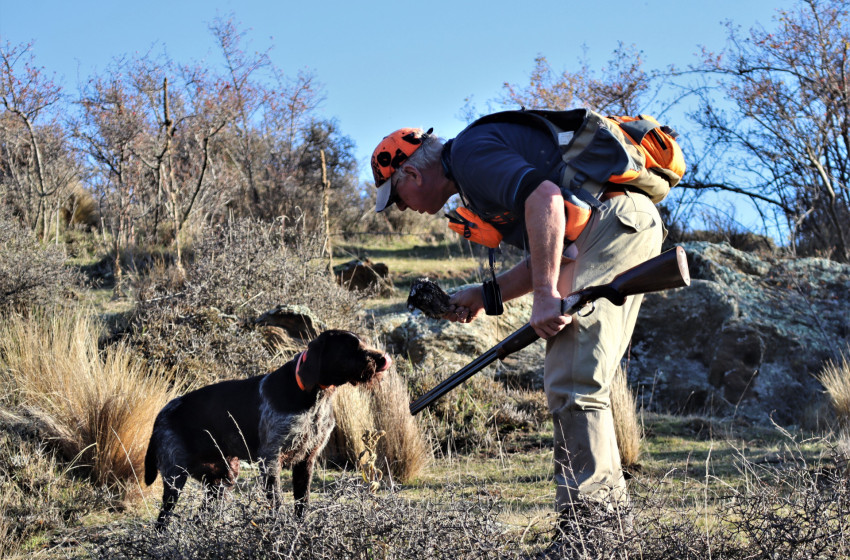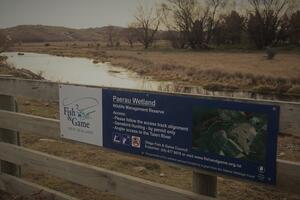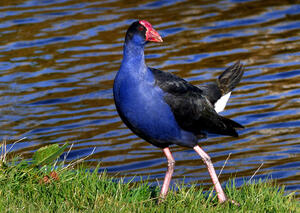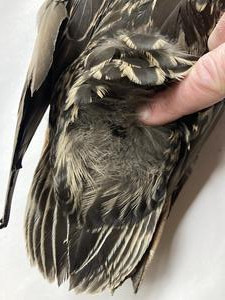Both Barrels July 2023 - Otago
- Otago
- 17/07/2023

Above: Bente, A delightful and determined Deutsch Drahthaar, gives up her quarry to the boss, David Dodd. Photo: Bruce Quirey
10 Tips for Upland Game Bird Hunting
Upland game bird hunting in Otago includes Californian quail, the elusive chukar and if you’re lucky enough to find any, cock pheasant.
Mostly it’s about quail in dry, inland hills of Central Otago. The season continues until the last weekend in August.
Here are 10 tips to get you going.
- Where to hunt: Some things are earned, not easily given. Permission to hunt on private land is one of these things. It is a product of establishing relationships and trust. Most quail hunting happens on private farmland. There are limited public opportunities on DOC land for which you will need to seek a game bird permit from the nearest DOC area office. If you don’t know where to start, then start somewhere in Central Otago. Seek out briar, broom, boxthorn, matagouri, manuka or gorse on hill country or shingle riverbeds. Knock on farmhouse doors. Ask for permission politely and respectfully. You are laying the groundwork not only for now, but for future opportunities.
- Best conditions: Bright, warm and sunny days are the most productive as Californian quail will be calling and moving about in these conditions. On cooler days, look for warm and sunny hill faces. If it’s pouring with rain, perhaps do something else, like waterfowl hunting or preparing for the next fishing season.
- Look and listen: Californian quail are often heard before they are seen. Their distinctive “chi-kaw-go” assembly call may help you identify where a ‘covey’ is holding.
- Learn how to call: This article from the US publication ‘Project Upland’ offers some useful tips on when and how to use a quail call to locate a covey. A well-timed call may even see quail come to you.
- Shake, rattle and roll: An undisturbed covey will sit tightly on the ground or in bushes. Quail can sit so tight, sometimes you’ll need to shake a bush or toss a rock to flush them out.
- Pick your target: When a covey is flushed, pick out an individual bird to shoot, give it plenty of lead and swing through the shot.
- Close encounters: Quail fly short distances and will return to ground where they re-group and sit tight. They will often fly across and downhill from gully into another, not too far from where first disturbed.
- Canine squad: A well-trained dog is an essential part of the team to locate, flush and retrieve quail. It’s easy to lose sight of your dog working in thick scrub and you may not be aware if they are on point holding a covey. A collar beeper that activates when the dog is stationary will soon let know you.
- Pay attention to dog: After a covey flushes, your dog may indicate other birds still sitting tight in the same location. From previous, painful experience, we can say with authority the dog is often proved right. Be ready for Johnny-come-lately to burst out of the bush after the party has moved on.
- Duty of care: Tapeworm causes sheep measles, a serious threat to farmers’ livelihoods. Infected dogs can pass on thousands of tapeworm eggs to sheep or lambs by defecating in pasture. It is the hunter’s responsibility to ensure their dog is correctly dosed for tapeworm. A tapeworm drug containing Praziquantel needs to be administered to your dog at least 48 hours or within a month before going hunting. Carry proof of treatment such as an Ovis certificate, a vet receipt, or at least offer proof of purchase and note the dosage date.
Last-chance mallard malarkey

Paerau Wetland was secured as a Fish & Game wildlife management reserve through the Nature Heritage Foundation and is available for seasonal game bird hunting (by permit only) and fishing. Photo: Bruce Quirey
Make the most of the last two weeks of the Otago game bird season for mallard, grey and shoveler ducks as the season ends on July 30.
Ducks will be starting to pair up.
It’s a good idea to leave alone your preferred maimai pond at this late stage of the season or risk disturbing pre-brooding birds and affect numbers for next year.
Consider hunting at other locations, such as riverbeds and large wetlands.
You only need a small decoy spread at this time of year.
Once birds pair up, other lone drakes will still be looking for a partner.
These loners can be called into a small spread of separated pairs.
Wetland permits
Game bird hunting permits are available for Fish & Game-managed hunting reserves, including the 45ha Paerau Wetland in the Upper Taieri scroll plain.
A recent hunting trip to the wetland encountered no mallards on the day but paradise shelduck and black swans.
Conditions were icy with snow melt. Access to the wetland is via a gated 4wd track which begins at the Logan Burn bridge on Upper Taieri-Paerau Road. Phone our Dunedin office (03) 477 9076 to request a permit.
Swan lake

Black swans on Lake Waihola. Photo: Bruce Quirey
The Otago season for black swans continues until August 27. They can be hunted in the Clutha catchment downstream of the Clyde dam, and all waterways flowing into the sea in Otago. There is a daily bag limit of 10.
Swan usually fly the same path to and from a wetland at dawn and dusk. Careful observation will put you in the right place to hunt them passing at first and last light.
Lean swan meat is typically made into sausages or salamis, and they are good for schnitzel and stir-fries.
In Central Otago, there is a zero bag limit of swan in the Clutha River catchment upstream of Clyde Dam.
Just like living in paradise
The 2023 winter season for paradise shelduck/pūtangitangi continues in Otago until August 27.
The next Otago “summer” paradise shelduck season is from Monday, March 4, to Tuesday, March 12, 2024. Be sure to set your sights on the weekend that these dates straddle.
Due to an administration error that cannot be undone, the “summer” season covers only one weekend.
Fish & Game regrets any inconvenience.
Seen a potter of pukeko?
 Did you know the collective noun for pukeko is a potter?
Did you know the collective noun for pukeko is a potter?
Fish & Game is researching pukeko populations throughout Otago for their responsible management.
We have been monitoring pukeko populations at selected sites for decades.
There is anecdotal evidence that the range of pukeko is expanding in the region.
We want to hear of any sightings of pukeko groups numbering 10 birds or more.
Please contact Steve Dixon, sdixon@fishandgame.org.nz
Water off a duck’s back
Ever wondered where CDC feathers used in dry-flies for fly fishing come from?
Cul-du-canard (CDC) is French for “duck bottom”.

CDC feathers on the back of a female mallard. Photo: Bruce Quirey
They are found on the back of a duck directly around the preen gland and are naturally waterproofed.
Ducks rub the oil from this gland using their beak to waterproof the rest of their feathers.
CDC dry flies don’t require floatant. Why not put these and many other duck feathers to good use to make various fly fishing patterns?
Check out this YouTube video by Robbie Berry on gathering duck feathers for fly tying.
Jot these dates down
Otago game bird season closure dates:
- July 30 ─ grey/mallard/shoveler.
- August 27 ─ black swan (Area B) and paradise shelduck.
- August 27 ─ California quail, chukar, cock pheasant.
Paradise shelduck early autumn season:
- March 4-12, 2024
Hot barrels and safe hunting,
The Otago Fish & Game team